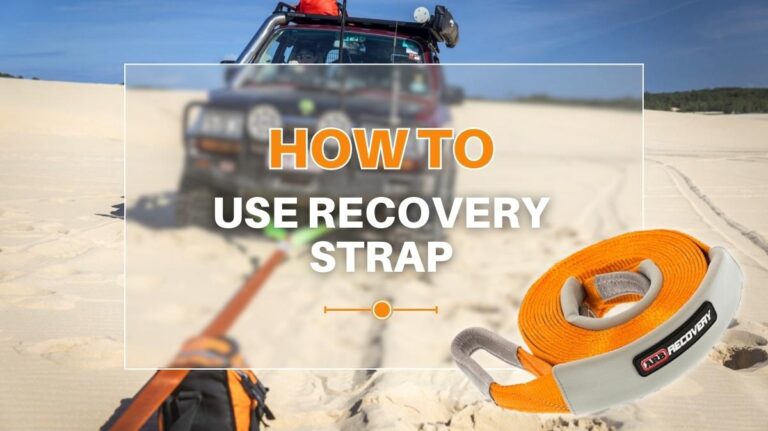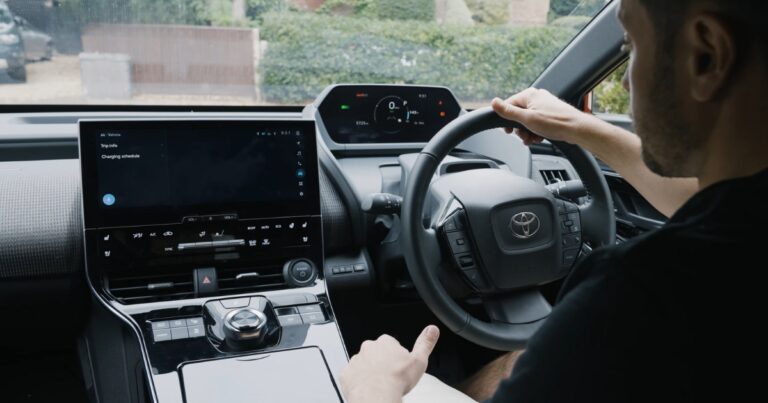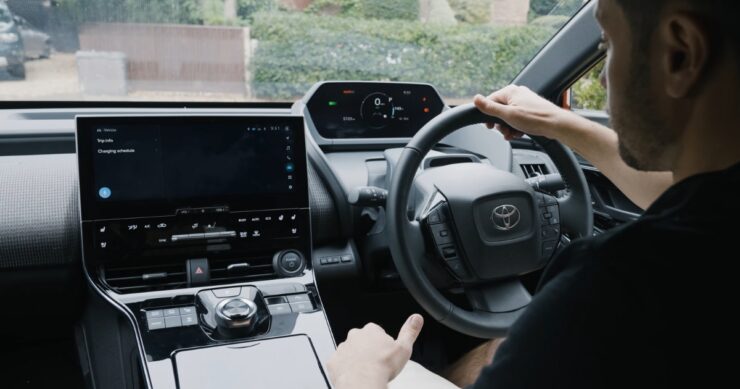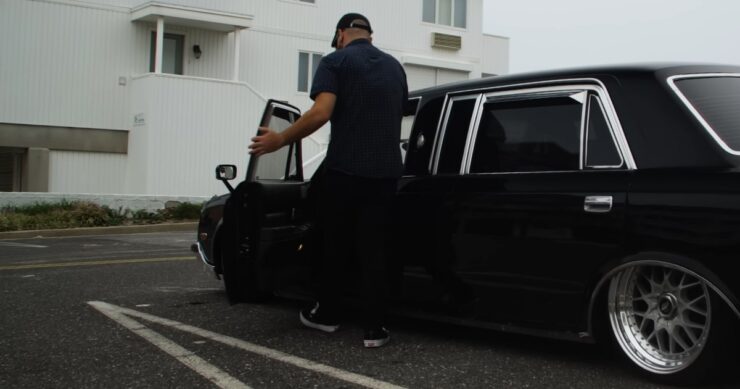Every car owner needs to learn and understand how to use a recovery strap, alongside its importance. Although having a positive mindset when driving on the road is commendable.
Having the proper measures in place keeps you ahead of possible challenges or issues that may occur unexpectedly.
Preparedness may not necessarily prevent issues such as breakdowns or accidents from happening on the road.
However, it ensures you do not become helpless when things do not go according to plan or expectation.
If you do not have a tow or recovery strap in your vehicle yet, make that decision today and update your gear.
With a recovery strap, you can safely get your car out of a difficult situation that may occur dues to bad road conditions. For instance, when trapped in snow or mud.
Also, who knows? You may as well be able to save someone’s car from a difficult situation with your recovery strap.
The great news is that straps are pocket-friendly, are not heavy, are easy to store and use, and don’t need any installation before you can use them.
Types of Straps
There are mainly two types of straps (tow and recovery), and each of them serves a distinct function. Better still, they are used in different conditions.
The use of tow and recovery straps are standard practices, and they must be used rightly.
This is another strap dedicated or designed precisely for car recovery.
Using the right strap for the right task makes is the ideal practice. This guarantees optimum safety and protection for your vehicle and the people around the scene.
Tow Strap vs. Recovery Strap
01. Tow strap
This is the most popular and widely available strap you will find online and in stores around you. In most cases, the tow straps are advertised to car owners as recovery straps.
Since tow straps are made from low-cost materials, they are more affordable than recovery straps. Also, they are mostly built or equipped with a metal hook at both ends.
The cheaper materials used in building this strap are never an issue when the strap is used appropriately.
When using this strap for towing, the construction materials provide constant/reliable pressure on the strap. This offers adequate support and control to the towed vehicle as it drives behind the car pulling it.
The metal hooks on the tow strap are not strong enough and could detach under extreme pressure or load.
Once it breaks loose from the point holding it in place, it becomes a safety issue. You can imagine the havoc or damage it could cause to the vehicle and the people around it.
The good news is that new designs of tow straps do not have metal hooks. Instead, they now have the hoop design. Although they are more expensive, they are safer.
While tow straps with hooks are generally considered safe while towing, especially when maintained with consistent pressure. If possible, avoid them for your towing operations.
Also, your tow strap should never be used for recovery.
For safety, use a towing strap with a weight up to 4 times the vehicle you are towing.
Features of tow straps
- Metal hooks at both ends
- Made from cheaper materials such as Polyester, Dacron, and Polypropylene.
- They do not stretch
- Length is usually about 20-inch long
- The width is usually 2 inches.
- Comes in various sizes
- Ideal for pulling vehicles and not extracting them
- They are strong enough to resist scratch or cut when they drag along the road
02. Recovery straps
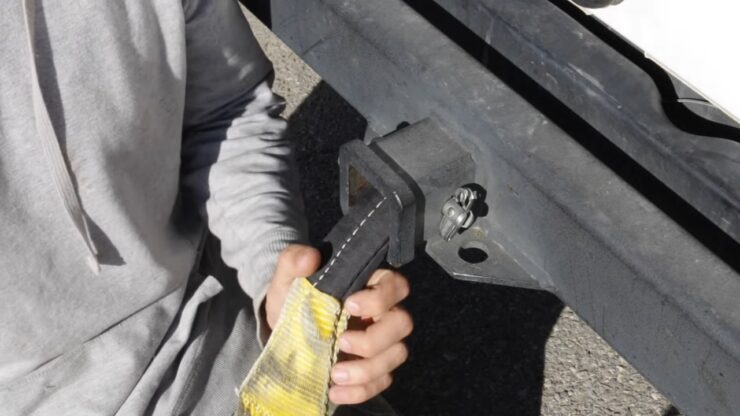
Recovery straps are built or designed using expensive and durable materials. They are constructed using top-quality nylon that guarantees elasticity.
This means the recovery straps will stretch when a load is applied and return to their usual length upon removing/detaching the load.
Depending on the strap’s width and the quality of the material used, a recovery material can stretch between 5 and 30 percent of its original length or size.
Stretching is an essential feature in every recovery strap. This action (stretching) stores kinetic energy, which is then released/disbursed rapidly to recover a trapped vehicle from its position.
As the recovery strap extends or stretches to a certain point or reaches its expansion limit, energy is disbursed as it returns to its actual length.
The energy released at this point is then transferred to the stuck vehicle, extracting it from where it’s trapped.
Features of recovery straps
- No metal hooks
- Made from quality nylon material
- Expensive, solid, and durable
- Stretch up to 30% of its actual size
- The width is usually between 2&3 inches.
- Length is usually about 30-inch long
- Ideal for vehicle extraction
Step-by-Step Guide on How to Use Recovery Strap
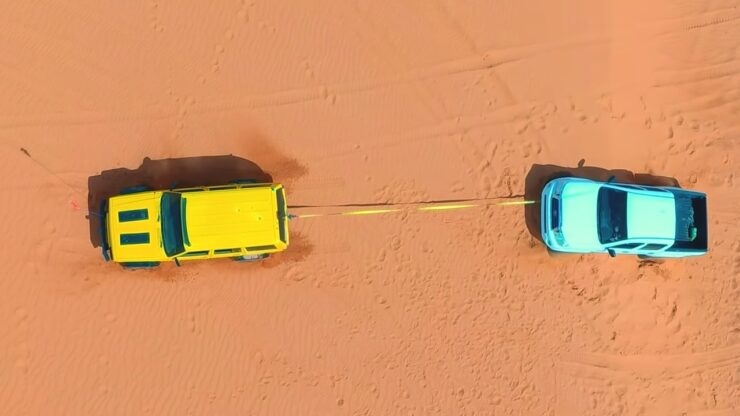
01. Check the condition of the recovery strap
Confirm the strap’s condition (free from dirt, knots, breaks, or cuts). This equipment must be in excellent condition and be safe for use at all times.
02. Use the hazard signal signs
Before you start the recovery operation, ensure you use hazard signals and safety triangles to inform other road users about what’s ahead.
03. Extend the strap
When you need to use the strap for recovery, lay it on the floor and extend it from the recovery vehicle to the stuck vehicle. Ensure the strap is completely flat and free from knots.
04. Attach the strap to the vehicles
Avoid attaching the strap to the bumper of either car or the tow hitch. These components are not strong enough to withstand the load or pressure resulting from recovery. You don’t want to damage them.
Both drivers can check their owner’s manuals to identify the appropriate attachment points for their vehicles.
05. Prepare for the recovery operation
Immediately after the strap has been successfully connected or attached to both vehicles, the drivers can get behind their wheels.
The recovery vehicle accelerates of moves forward more aggressively than what’s required for towing, thereby building enough energy in the strap to extract the struck vehicle.
While at it, you must maintain a slow movement to avoid an abrupt jerking motion, thereby preventing the recovery strap from snapping.
Also, the recovery vehicle should be placed in low gear to achieve greater torque. The struck vehicle can be placed on a higher gear as the driver applies enough gas to get the car out.
06. Get the stuck car to safety
Remove the vehicle from the trapped position and get it to safety. The driver of the recovered vehicle can then check if the car is safe enough to drive.
How to Use a Tow Strap
01. Check the tow strap
Your tow strap must be in excellent condition at all times. Before using the strap, conduct a proper check to detect any sign of breakage, knots, weakened fiber, or cut.
02. Use the hazard signal signs
While preparing the damaged vehicle for towing. Ensure you use hazard signals and safety triangles to inform other road users about what is ahead.
03. Confirm the strap’s length
Before you decide to connect the tow strap to both vehicles, check if the length of your strap is adequate for the task.
You can lay it on the ground, close to the pulling vehicle, and extend it to the car that needs to be pulled. If the strap seems inadequate, move the pulling vehicle closer and try again until both cars can easily connect.
04. Connect the strap
Attach the strap to the connecting point on both vehicles. You and the other driver can check your owner’s manual to confirm a safe and secure position to connect the strap.
Also, do not hesitate to check the manual that comes with your tow strap if you need extra tips.
05. Prepare the vehicles
Place the gear of the faulty vehicle or truck into neutral. This allows the car to move once towing starts.
The towing vehicle should accelerate slowly to eliminate the gap/slack in the strap. The towing operation can begin once the slack or space is removed and the strap is tight enough.
Ensure the strap remains tight until you reach your destination to eliminate jerking as both vehicles drive along the road.
Dos and Don’ts
Dos
- The recovery vehicle must drive towards an area with enough space to accommodate the free movement of both cars. The space must have no obstructions
- The strap attachment points must be strong enough to withstand the pressure that comes with this operation
- Ensure the straps are attached correctly on both vehicles
- Both drivers must embrace a reliable and agreed medium of communication throughout the recovery exercise
- Keep your tow and recovery straps in excellent condition at all times. Do not expose it to direct sunlight
Don’ts
- A towing strap should never be used in place of a recovery strap and vise versa
- Avoid aggressive acceleration as you attempt to pull the trapped vehicle out
- Do not connect the strap to fragile parts or components of the vehicle
- Do not buy a cheap (with hooks) tow strap. Pick any of the new/expensive designs
Some Common Problems and Solutions
01. Wrong labeling and packaging
As we discussed earlier, many tow straps are packaged as recovery straps. If you can’t differentiate between the two, you may pick up a tow strap thinking it’s a recovery strap
Solution
Make sure you conduct enough research and read reviews online to know the exact equipment or product you are buying.
02. Tow hooks breaking during use
Although a tow strap with hooks at both ends is less expensive and gives a feeling and impression of convenience and ease of attachment. It is not safe!
The hooks are not strong enough to handle an unexpected load. They could break from the connection points due to the absence of elasticity during use. This can cause damage to your vehicle or even injure someone.
Solution
Go for tow straps that do not have metal hooks. Although they are more expensive, your safety and that of others are guaranteed.
FAQs
When is the recovery strap used?
A recovery strap is used when a vehicle gets stuck and needs to be pulled out of a ditch, mud, sand, or snow.
The strap is typically used to pull the stuck vehicle out with the help of another vehicle.
The recovery strap is specifically designed to stretch and absorb the shock of the recovery process.
It is important to use a recovery strap that is rated for the weight of the vehicle being recovered and to follow proper safety procedures to avoid injury or damage to the vehicles involved.
It is also important to use appropriate recovery points on the vehicles and to avoid attaching the strap to inappropriate areas such as the bumper or suspension components.
How does the recovery strap work?
If you find your car stuck on the road due to bad road conditions, or you decide to help someone in such a situation. One end of the recovery strap is attached to the trapped car.
The other end is then connected to the recovery vehicle, which will pull the stuck vehicle out of that difficult spot.
Locate the frame-mounted hooks or D-ring attachment on your vehicle and attach the recovery strap accordingly. This process is applied to both the stuck and recovery vehicles.
How can I attach a strap to a vehicle that doesn’t have attachments or frame-mounted hooks?
If your vehicle doesn’t have attachments or frame-mounted hooks to attach a strap, there are a few alternative options you can consider:
- Use the tow hook: Many vehicles come with a tow hook, which can be found in the trunk or under the bumper. You can use the tow hook to attach the strap to the vehicle.
- Wrap the strap around a sturdy part of the vehicle: If there are no hooks or tow points available, you can wrap the strap around a sturdy part of the vehicle such as a metal frame, axle or suspension component. Make sure the strap is tight and secure before using it.
- Use a trailer hitch: If your vehicle has a trailer hitch, you can use it to attach the strap. Make sure the hitch is securely attached to the vehicle and that the strap is properly secured to the hitch.
- Install aftermarket attachments: If you plan to use straps frequently, you can install aftermarket attachments such as D-rings or tie-down points to your vehicle’s frame. This will provide you with a secure attachment point for your straps.
Why is it not safe to use a tow strap for recovery?
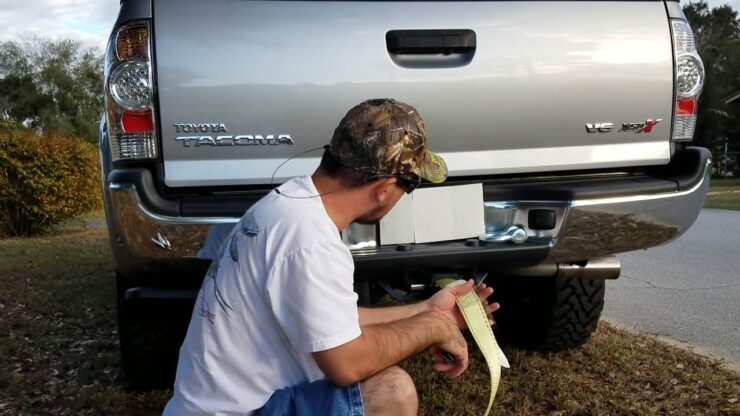
A tow strap has a hook attached to each end of the line. The hooks could break under excessive pressure or load if you attempt to pull out or release a sunk vehicle with it instead of a recovery strap.
When the hook loses or breaks, it does at a high speed. This could go as far as hitting someone or a vehicle around.
How to perform a successful recovery task?
The most important attribute you need during a recovery exercise is patience. If it is not an emergency recovery operation, ensure you totally avoid being in a rush. The slower the execution, the better the result.
Once the appropriate attachment points have been identified, fasten the strap to both vehicles securely and firmly.
Also, make sure people keep a safe distance to avoid getting hurt or injured if something goes wrong.
What are the tools, materials, or equipment needed during a recovery operation?
The primary tool is the recovery strap. You also need to keep the hazard warning lights on and use the safety triangles. The drivers need a reliable means of communication.
The drivers could decide or choose to talk on the phone. Alternatively, another driver may volunteer to coordinate the exercise using hand signals.
Verdict
Knowing how to use a recovery strap is not enough. Every car owner must ensure they add this vital equipment to their automotive gear.
Recovery straps are perfect for minor issues with your vehicle. They should never be seen or considered as a direct replacement for a tow vehicle.
For instance, if your car breaks down and is not in the right condition, you need to tow it.
While recovering or towing a vehicle, the drivers involved must clearly understand what the project is all about.
Remember, your safety is vital during the use of the towing and recovery straps. Ensure you pay close attention to your surroundings and follow the recommended safety tips.
Related Posts:
- When to Use the VSC OFF Button in Your Toyota…
- How to Install and Use a Linear Actuator for Your Smart Bike
- Top 9 Best Battery For Toyota Tacoma 2024 - Heavy…
- Top 10 Best Cold Air Intake For Tacoma 2024 | Great…
- 10 Best Shocks For Toyota Tacoma 4x4 2024 - Heavy…
- How To Reset Toyota Entune System | Simple & Easy Steps 2024

